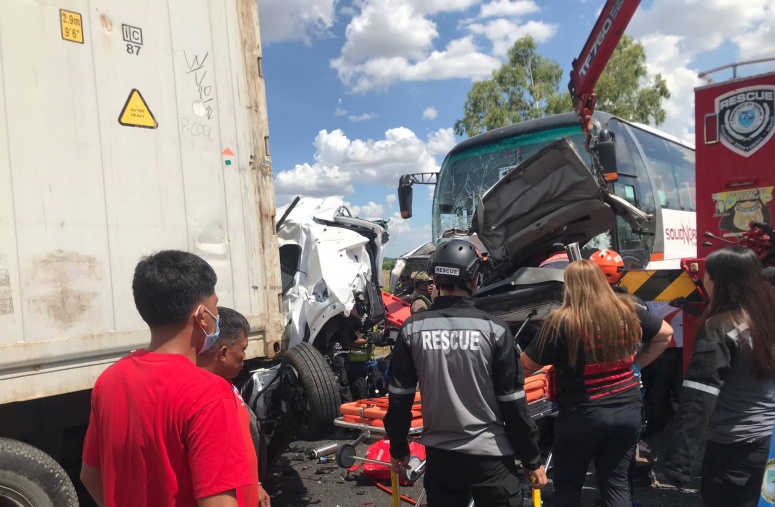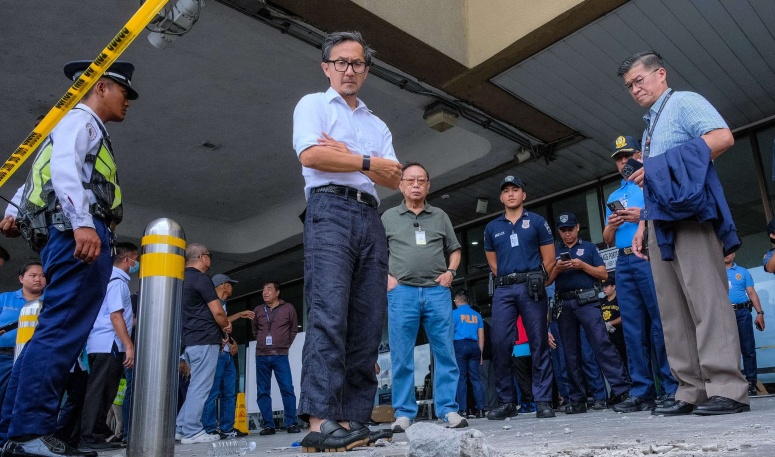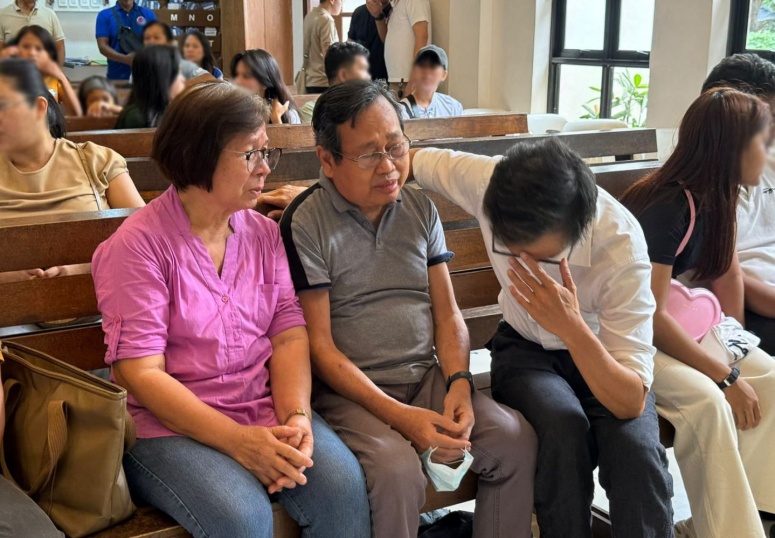SCTEX, NAIA crash incidents spark calls for more stringent driver's license requirements, stricter traffic rules
The Philippines observes Road Safety Month every May but ironically, two fatal driving accidents already took place in the first week alone.
On Labor Day, a multi-vehicle collision involving a bus, three cars, and a closed van truck ensued along the northbound lane of the Subic-Clark-Tarlac Expressway. Ten individuals, including four children, were killed while 37 others, including the bus driver and the conductor, sustained injuries.
On May 4, a sports-utility vehicle crashed into the passenger entrance of Ninoy Aquino Terminal Airport, killing two individuals, including a four-year-old, and injuring four others.
The incidents triggered calls to make driver's license applications more stringent and traffic rules stricter. After all, many view the system as already long broken, if not corrupt.
Acclaimed photojournalist Ezra Acayan, in a now-viral Facebook post, recalled committing a traffic violation over a decade ago and the need to undergo a road safety seminar and exam at the Land Transportation Office headquarters before retrieving his license.

But Acayan recalled alleged abusive practices in which LTO staff asked for money in exchange for passing the exam. Nevertheless, he said the test sheets had answers already marked in pencil.
During the seminar, he recalled them watching the NBA Finals instead of safety videos on driving.
As they retrieved their licenses, Acayan recalled it being a joking moment in which it became a supposed graduation ceremony with the announcement of names and clapping of hands.
"After this week’s tragic events, I can’t help but wonder if the people responsible for claiming those innocent lives and destroying families sat in that same room with me years ago," he said.
"[W]here, instead of being sternly reminded how to drive safely, we just watched a basketball game. Where, instead of having to prove we were still competent enough to operate large machines capable of killing, we walked away without even a slap on the wrist," he added.
While Acayan's account is lone and anecdotal, it didn't diminish the idea that the recent accidents may have already been the last straw. They also reinforce two things: that the country's roads are unsafe, and the transportation system needs to be overhauled.
'The system is broken'
The Department of Transportation and its agencies, the LTO and the Land Transportation Franchising and Regulatory Board, in a press briefing on May 5, lamented the recent accidents.
"Hindi ito ang hustisya sa pagbigay ng compensation sa mga pamilya ng namatay, sa pagfile ng mga criminal at civil cases... hindi dito hihinto ang hustisya," said DOTr Sec. Vince Dizon.
"The system is broken. Kami po, andito sa gobyerno... It's broken, we have to admit that," he said.
As a path forward, Dizon gave a laundry list of concrete steps the department is taking to deal with the perennial problems in the system, as exacerbated by recent events.
He said he issued a department order that requires public utility vehicle drivers to undergo mandatory drug testing "regularly," which may be done every 90 days.
Dizon said the DOTr, LTO, and LTFRB will be working with the Philippine Drug Enforcement Agency to implement the order.
Dizon said he also told the LTFRB and LTO to revise the maximum number of consecutive hours that PUV drivers can travel, to four hours from six hours. He also required bus companies to have two drivers taking turns.
"Ang ginagawa, ang konduktor siya din ang ginagawang karelyebong drayber. Hindi po pwede na 'yun," he said.
Dizon also called on conducting “real” road-worthiness assessments of PUVs, as well as enforcing “very strict, enforceable, and regular” checks akin to other countries' practices.
Dizon bluntly said that the country's roadworthiness checks are only approved due to bribes.
"Huwag na tayo maglokohan. Alam naman natin na ang road worthiness checks sa atin, hindi naman 'yan totoo," he said.
He also called the present driver and training exams as "lokohan," while practical exams are "atrasante."
"Alam naman natin 'yan. Di ba, bibigyan ka lang ng kodigo diyan, magbabayad ka lang ng P1,000 or P1,500. Bibigyan ka ng kodigo, pasado ka. 'Yung mga [driving] seminar nga, pelikula lang ang pinapanood diyan," Dizon said.

He asked the LTO and LTFRB to "fix the system."
He also wanted a stricter driver's education and a stronger implementation of the Road Speed Limiter Act of 2016, which requires the installation of a device that sets the level of a vehicle's maximum speed. It still doesn't have implementing rules and regulations to date.
“This needs to be implemented immediately," Dizon said, adding that the speed limiter must have more than one supplier already.
"That needs to change. I want it open, a free market. Everybody who complies with standards can supply that," he added.
Dizon is also backing Sen. Grace Poe's call for the creation of the Philippine Transportation Safety Board, which “will establish a sole agency in charge of investigating transportation-related accidents and incidents in air, land, and sea, including railways and pipeline systems.”
He reminded the public that a driver's license is a privilege and not a right, and the government may revoke licenses for irresponsible actions.
He also announced the creation of a task force—composed of the DOTr, LTO, and LTFRB—to conduct a sweeping review of the existing road safety policies and the processes of drivers’ license issuance.
“Bakit ang daming kamote drivers? Ang ibig sabihin niyan, hindi sapat ang mga proseso natin ngayon para siguraduhin na kwalipikado at skilled ang mga drivers natin,” he said.
'We will ensure they never happen again'
Hours after the press conference, President Ferdinand "Bongbong" Marcos Jr., in a video message, said they will ensure the incidents never happen again.
He said they're taking the following actions:
- A review of driver licensing to ensure that only fit, capable, and responsible individuals—whether driving public or private vehicles—are allowed on the roads;
- A nationwide audit of bus operators, with clear sanctions for those who fail to comply with safety and maintenance standards; and
- A directive to the DOLE to crack down on unsafe and exploitative practices in the transport sector, as driver fatigue, long hours, and pressure to meet quotas should never put lives at risk.
"We owe it to the victims and their families to act—not only with sympathy, but with resolve," Marcos said. "These lives will not be lost in vain. We will make the changes that need to be made. We will demand accountability where it is due. And we will build a transport system that truly protects Filipino people."
The president also instructed Dizon to "move decisively" by identifying and holding those responsible accountable.
Low-skilled labor
Road safety advocate James Deakin told PhilSTAR L!fe that one of the systemic issues that leads to such tragic incidents is the lack of respect and dignity given to driving as a discipline.
"Driving is often treated as low-skilled labor with minimum wage pay, despite requiring the responsibility and precision of roles like licensed tradesmen, engineers, pilots, or ship captains," Deakin said. "This undervaluation contributes to inadequate training, poor accountability, and a culture that fails to prioritize road safety."
Deakin believes that to prevent accidents, the government must first address the root causes: licensing and driver education.

He said road safety education should begin in academic institutions, not merely driving schools.
Before students get behind the wheel (at least 16 for a student permit), Deakin said they must take courses on pedestrian rules, which must eventually progress to driving principles.
He noted that driver testing must be outsourced to a neutral third party, preferably international or automated, to eliminate corruption.
"AI can assist in creating fair, standardized tests," he added. "We just need more natural intelligence to actually implement these reforms."
Stronger penalties
Poe, meanwhile, in a May 2 statement, noted that Republic Act No. 10930, which not only extends the validity of driver's licenses from 5 to 10 years but also penalizes acts in violation of the Land Transportation and Traffic, is envisioned for drivers who put a premium on road safety.
Poe said it has a provision imposing a penalty on any officer who would issue a driver's license "without the necessary examinations, connives with the applicant for the irregular issuance of a license, or who, by gross negligence, issues a driver's license to an unqualified applicant." Applicants who connived with a transportation officer, cheated during exams, or falsified documents must pay a fine of P20,000.
"Let's penalize the violators and reward the drivers with a clean record. The license is a privilege that comes with serious responsibilities," Poe said.
During the press conference, Dizon also called on the LTO to automatically impose a 90-day suspension on traffic violators. He also called on the public to document cases of traffic violations and post them online.
“I have given instruction to the LTO and I’m asking our citizens: May makita kami na post sa social media na nag-aabusadong driver, automatic suspendido 'yang lisensya 90 days,” Dizon said. “Walang imbe-imbestigasyon, walang hearing-hearing, pag may nakita kami na may video, na may pruweba na umaabuso kayo sa kalye, suspendido kayo."
As for the recent tragedies, Dizon said the license of the bus driver involved in the SCTEX crash was revoked with perpetual disqualification. They will also push through with the filing of civil and criminal cases against the Pangasinan Solid North Transit Incorporated, which must pay compensation to the victims' families "over and above" the usual third-party liability insurance.
As for the NAIA crash, the suspect's license is suspended for 90 days pending investigation.
Dizon said the LTO also revoked the license of 98 motorists who tested positive in a drug test conducted during the Holy Week. He also announced the 90-day suspension of 671 licenses of drivers involved in road crashes and illegal drugs during the period.
Of 671 licenses suspended, 574 are from drivers involved in road crash incidents that resulted in injuries and deaths, while the remaining 97 are PUV drivers who tested positive for illegal drugs.

“We are sending a strong message to everyone, lalo na sa mga nagpapatakbo ng mga PUVs – buses, jeepneys and other PUVs, hindi po natin itotolerate ‘to," he said. "At sa mga nagmamaneho ngayon, tumino-tino na po kayo kung ayaw ninyong mawalan ng kabuhayan."
The recent events also brought back conversations about Vietnam's stricter traffic rules since January.
The New York Times reported that traffic fines have risen tenfold, with the biggest tickets exceeding $1,500 (PhP 83,000).
As it exceeded the average monthly salary of many, it was "more than enough to change behavior," the report stated, with intersections becoming "both calmer and more congested by an outbreak of caution." Faulty green lights "even led scared drivers to walk motorbikes across streets the police might be watching."
Vietnamese authorities also announced plans to add 40,000 cameras to the 20,000 already in place across the capital, Hanoi, for increased surveillance.
Fines for cars that don't stop at red lights, for instance, went to 20 million Vietnamese dong (PhP 42,800) from 6 million (PhP 12,800), according to Viêt Nam News. Even opening a car door open or leaving it open in an unsafe way incurs a fine of VND 22 million (P47,100), from 600,000 (PhP 1,200).
Khuong Kim Tao, former deputy chief of Vietnam's National Traffic Safety Committee, told state media Bao Dien Tu Chinh Phu, according to the Vietnam Law & Legal Forum magazine, that traffic accidents "have decreased compared to before, but are still at an alarming level and pose many risks."
More that need to be done
As for Dizon's plans, Deakin said that while they're positive steps, there are more that need to be done, particularly with the drug testing proposal.
He warned that mandatory drug testing programs may turn into revenue-generating schemes extorting innocent drivers while letting the guilty slip through.
"To prevent this, implement random drug testing by rotating teams, similar to athlete testing, to avoid collusion with bus companies," he said.
He also called for the IRR of the speed limiter law, noting that it would enhance safety as buses and trucks would be capped at 80 kilometers per hour.
As for Poe's proposal, Deakin said it could be a step forward only if it avoids becoming another layer of bureaucracy.
"The board must be led by qualified individuals who are genuinely invested in reform, not the same recycled appointees or rotating meatballs," he said. "We need leaders with expertise and accountability, or someone with actual skin in the game, not benign figureheads issuing press releases or forming ineffective committees."
"A well-executed board could drive meaningful change, but it must deliver results, not excuses," he added.
Stricter rules better than increased fines
For psychologist Wenna Brigaste, a more consistent and stricter implementation of rules, instead of increased fines and other penalties, would help make drivers more mindful and careful when driving.
"Government agencies should likewise be stricter in their requirements for people to get a driver's license," Brigaste told L!fe.
She believes in the power of reinforcement over punishment.
"Proper training and education would be beneficial. Refresher courses, better road conditions, and improved work conditions for drivers will likewise be advantageous," she said.
Deakin said that aside from the filing of cases against erring drivers (such as reckless imprudence resulting in homicide for the NAIA driver), a comprehensive evaluation is a must.
"This includes a mental health assessment, a thorough drug test to rule out substance involvement, and an investigation into how and where the driver obtained their license," he said.
In the NAIA driver's particular case, seemingly minor factors must be taken, with Deakin noting the driver was seen exiting the vehicle wearing slippers.
"[That's] unsafe, as they can get caught on pedals, potentially causing unintended braking or acceleration. This suggests negligence, which should be factored into the penalties," he said.
Getting a driver's license
In the Philippines, there are three kinds of driver's licenses: a student permit,a non-professional license, and a professional license.
The student permit, which can be availed at 16, is a prerequisite for an actual license. It's valid for a year and allows them to drive a motor vehicle as long as they're accompanied by a licensed driver.
A non-professional license allows an individual to drive any private automobile on their own. It's valid for five years unless suspended or revoked. They're entitled to renewal with a 10-year validity if they didn't commit any traffic violations during the five-year period.
A professional license is for those who operate or drive a public or private vehicle for a living. It has the same validity rules as a non-professional license.
General requirements for getting a driver's license include being: physically and mentally fit; able to read and write; neat, clean, and presentable; well-dressed; not having an unsettled traffic violation; and passing the written and practical driving exam.
Foreign applicants must also have proof of residence in the Philippines for at least a month and must be staying at least a year from the date of application.
The LTO provides a comprehensive guide on the requirements and procedures for obtaining the three kinds of licenses.
Defensive driving
Talks of defensive driving also got a resurgence amid the crashes.
The LTO, on its website, said it "entails a proactive approach to road safety, emphasizing hazard awareness, anticipation of potential risks, and a swift response to unexpected situations."
Defensive driving includes planning ahead, controlling your speed, staying alert, keeping a safe following distance, preparing for road hazards, avoiding distractions, passing with care, and remaining calm.
The LTO said defensive driving involves "SIPDE":
- Search - continuously scan the road ahead and check your mirrors to identify potential hazards
- Identify - recognize any potential dangers or obstacles that may require evasive action
- Predict - anticipate the likely actions of other drivers or road users based on their behavior and surroundings
- Decide - make a proactive decision on how to respond to potential hazards
- Execute - act swiftly and decisively to implement your chosen course of action and avoid the potential hazard
Comprehensive data analysis
Last April, the LTO said it embarked on comprehensive data analysis for holistic government intervention on road accidents.
The study and analysis have a focus on three main factors of road accidents: human or motorist factor, motor vehicle factor, and infrastructure factor.
It said the results will serve as the basis for the adjustment of strategies on law enforcement and recommendations for stricter penalties for certain road safety and traffic rules regulations.
Last year, the LTO launched the “Stop Road Crash” advocacy, which aims to lessen road accidents by 35% by 2028.
The agency cited several data points, including from the World Health Organization, which stated that around 1.3 million people die in road accidents around the world. Between 20 million and 50 million individuals get injured, including permanent disability.
United Nations data, meanwhile, stated that around 58% of the 1.3 million fatalities in worldwide road accidents happen in the Asia-Pacific region.
In the Philippines, an average of 32 people die every day due to road accidents. The Philippine National Police, for its part, reported there were 2,747 road fatalities in 2024 versus the 2,030 fatalities in 2023, which amounts to a 35% increase.
About 27,248 or 87% of the road accidents were caused by reckless driving, including bad overtaking, improper turning, speeding, drunk driving, overloading, and using mobile phones while driving.
Brigaste noted that while the recent incidents could cause stress among commuters, trigger a sense of grief in online spectators who see videos and reports—even stir anger of many toward reckless drivers and the government—they could "create worry and a sense of panic" among Filipinos, drivers or passengers alike.
"That could be good since people become more mindful," she said, "and hence, become more careful."



